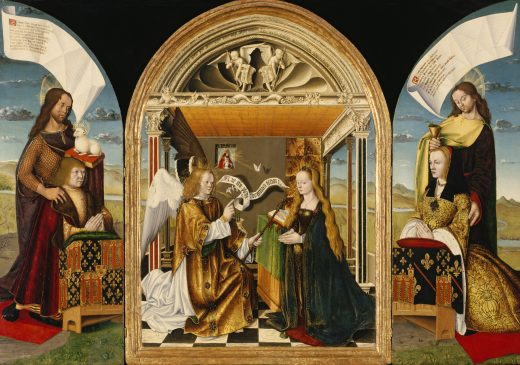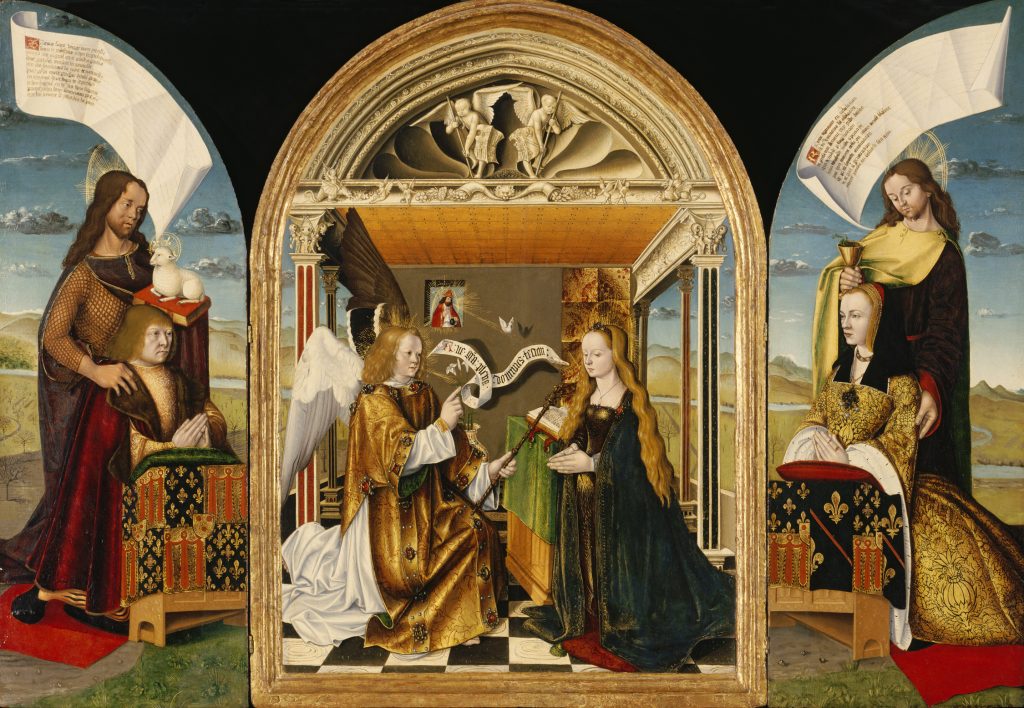1. Introduce students to the Latour d’Auvergne Triptych. Ask:What stories are depicted here? (Annunciation, lives of donors, lives of patron saints) How did the artist organize the stories? (Annunciation in the center, more contemporary stories on the sides) Which is the most important story in the painting? How do you know? (Annunciation; center location is more important because viewer instinctively looks there first) How did the artist show the stories are related? (common background, side figures look toward middle, scrolls above donors’ heads are prayers that the couple would be blessed with a child)
Tell students that artists traditionally place the most important aspect of the story in the center of a painting. They draw our attention to this action by using bright colors, interesting details, and gestures.
Ask: What are some ways writers focus our attention on the essential story or plot? (character development, interrelationships between characters, detail of setting, dialogue) What are some strategies readers can use to determine which story is most important? (reader’s prior experience, making connections with characters, author’s purpose)
2. Choose a text that has a central plot and multiple subplots, such as “The Last Leaf” by O. Henry, Anne Frank: The Diary of a Young Girl, or any short story or novel-length book the teacher has planned to use during the course of the year. Model multiple plot analysis with a short read aloud. Have students read this text and keep a journal of their progress, making notes or completing a triple Venn diagram or a concept web of the various stories they see unfolding, the relationships developing between them, and their predictions about the upcoming action. When they have completed the text, have students reconsider their notes and make a final determination about which story was primary and which stories were secondary. Have them write a final journal entry justifying their determination, describing how the subplots supported the central one and the techniques the author used to concentrate the reader’s attention on the main story. Model this type of writing, helping the students to stay objective and not include personal opinion.
3. Instruct students to create a triptych that illustrates the assigned text, placing the primary plot in the center of the work of art and the subplots to the right and left. Students may enlarge or transfer the triptych template to white cardboard or foam core and depict their stories with paints, colored pencils, markers, or another medium of their choice. Before they begin, encourage students to consider the following:
Which part of the action will you use to represent the full story? Which characters will you depict?What are some additional details that are necessary to communicate the story to the viewer?How will you show the relationship of these stories to one another?What will be the setting of your stories? What are some details that will help the viewer identify the setting?What problems do you anticipate as an artist? Consider multiple solutions before making a decision.
4. Display these triptychs in the classroom and discuss as a class.Was there one common story represented in each of the triptychs?How did students represent it differently? What were some similarities?How does seeing these triptychs aid understanding of the literature?What are some relationships between art and other disciplines?
5. Have students write a journal entry after analyzing the class triptychs. How did the use of art aid understanding of the literature? How did the literature influence the art?


